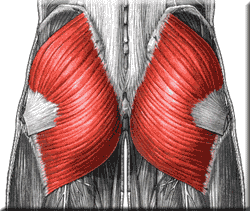 What to do with your big butt muscle, gluteus maximus, during the yoga practice is a source of endless confusion for students and teachers alike.
What to do with your big butt muscle, gluteus maximus, during the yoga practice is a source of endless confusion for students and teachers alike.
While I am big on saying relax your butt it isn’t relaxing—it is an issue of whether it is working correctly or not.
When I teach people posture I say that the gluteus maximus should be completely relaxed when we are standing as it has no role to play when we are up on two feet.
But in yoga class it has something to do in almost every pose—I just think it is often doing to wrong something.
Using bridge pose as a guide to know what the gluteus maximus should be doing in backbends can be very helpful.
One of my essential instructions is that there should never be any thrust in a backbend. If you are using thrust to get into a bridge, wheel, or any variation thereof, you are most likely using the gluteus maximus incorrectly.
The gluteus maximus, like the hamstring, is an extensor muscle that runs down the leg.
The gluteus maximus is one of the muscles that brought us up to standing from all fours.
The downward pull of these big butt muscles brought the pelvis to its neutral upright position and allowed the spine to come vertically.
Most people come to the bridge by tucking the pelvis under and lifting the hips up.
This tends to make the gluteus maximus grip up towards the belly rather than extend down the leg.
I often teach bridge with a block between the thighs and instruct that the feet should stay still and grounded and the inner thighs should remain connected to the block which wants to move down towards the floor rather than up towards the ceiling.
The fairly standard (incorrect) use of the butt in bridge forces the hips up by gripping the gluteus maximus which takes us to the outside of the feet and pulls the inner thighs away from the block.
When the gluteus maximus is doing its thing correctly in this pose, the feet don’t move and the inner thighs stay connected to the block.
If you want to feel what the gluteus maximus should do in bridge come into the pose and isometrically (which means that the feet won’t move) drag the feet energetically towards the hips.
You should feel both the gluteus maximus and the hamstring extending in the direction of the feet.
Don’t worry too much about right and wrong but do the pose repeatedly to see what your habits are as you move into bridge. Get to know how you use these all-important muscles and you might find that you need to change your approach a little bit.
